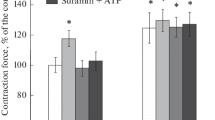Summary
The fine structure of the cat soleus neuromuscular junction was studied following a single intra-arterial injection of di-isopropylfluorophosphate (DFP) into the right femoral artery. DFP induced separate subacute and delayed morphologic changes in soleus non-myelinated motor nerve terminals. Three days after DFP administration motor nerve terminals were reduced in number. Subacute DFP damage was also noted in the subneural apparatus and in the immediate subjacent muscle. Both pre- and post-junctional subacute changes were resolved two weeks post-DFP. One week following this initial regeneration, soleus motor nerve terminals underwent a delayed transient degeneration, followed by reinnervation of damaged endplates 6–8 weeks following DFP.
Quantitative analysis of methylene blue-stained intramuscular nerves indicated that both subacutely and chronically denervated soleus muscle fibres were reinnervated by regeneration of the original motor axon. Reinnervation by means of collateral sprouting was insignificant. This mechanism of reinnervation and the rapidity with which it occurred suggests that both subacute and delayed soleus motor nerve damage is initiated from local actions of DFP on the non-myelinated terminal. The subacute reaction probably results from a direct cytotoxic action of DFP at pre- and post-junctional sites. The delayed nerve terminal degeneration may also stem from an acute effect not immediately detrimental to nerve function.
Similar content being viewed by others
References
Andersson-Cedergren, E. (1959) Ultrastructure of motor endplate and sarcoplasmic components of mouse skeletal muscle fibers as revealed by reconstructions from serial sections.Journal of Ultrastructure Research 1, (suppl) 1–91.
Ariens, A.Th., Meeter, E. Wolthuis, O. L. andVan Benthem, R. M. J. (1969) Reversible necrosis at the endplate region in striated muscles of the rat poisoned with cholinesterase inhibitors.Experientia 25, 57–9.
Baker, T., Glazer, E. andLowndes, H. (1977) Subacute neuro-effects of diisopropylfluorophosphate at the cat soleus neuromuscular junction.Neuropathology and Applied Neurobiology 3, 337–50.
Barker, D. andIp, M. C. (1965) Sprouting and degeneration of mammalian motor axons in normal and deafferented skeletal muscle.Proceedings of the Royal Society of London, Series B 163, 538–54.
Bischoff, A. (1967) The ultrastructure of tri-ortho-cresyl phosphate poisoning— I. Studies on myelin and axonal alterations in the sciatic nerve.Acta Neuropathologica 9, 158–74.
Cavanagh, J. B. (1964a) Peripheral nerve changes in orthocresyl phosphate poisoning in the cat.Journal of Pathology and Bacteriology 87, 365–83.
Cavanagh, J. B. (1964b) The significance of the ‘dying back’ process in experimental and human neurological disease.International Review of Experimental Pathology 3, 219–67.
Coers, C. andWoolf, A. L. (1959)The Innervation of Muscle: A Biopsy Study. Oxford: Blackwell.
Couteaux, R. (1951) Remarques sur les méthodes actuelles de détection histochimique des activités cholinesterasiques.Archives Internationales de Physiologie 59, 526–37.
Drakontides, A.B. andRiker, W. F., Jr. (1978) Functional, pharmacologic, and ultrastructural correlates in degenerating rat motor nerve terminals.Experimental Neurology 59, 112–23.
Engel, A., Lambert, E. andSanta, T. (1973) Study of long-term anticholinesterase therapy: Effects on neuromuscular transmission and motor endplate fine structure.Neurology 23, 1273–81.
Fenichel, G. M., Dettbarn, W. D. andNewman, T. M. (1974) An experimental myopathy secondary to excessive ACh release.Neurology 24, 41–5.
Fenichel, G. M., Kibler, W. B., Olson, W. H. andDettbarn, W. (1972) Chronic inhibition of cholinesterase as a cause of myopathy.Neurology 22, 1026–33.
Fenton, J. C. F. (1955) The nature of paralysis in chickens following organophosphorous poisoning.Journal of Pathology and Bacteriology 69, 181–9.
Guth, L. (1968) ‘Trophic’ influences of nerve on muscle.Physiological Reviews 48, 645–707.
Henneman, E. andOlson, C. B. (1965) Relations between structure and function in the design of skeletal muscle.Journal of Neurophysiology 28, 581–98.
Laskowski, M. B. andDettbarn, W. D. (1975) Presynaptic effects of neuromuscular cholinesterase inhibition,journal of Pharmacology and Experimental Therapeutics 194, 351–61.
Laskowski, M. B., Olson, W. H. andDettbarn, W. D. (1973) Ultrastructural changes at the motor endplate produced by an irreversible cholinesterase inhibitor.Experimental Neurology 47, 290–306.
Lowndes, H. E., Baker, T. andRiker, W. F., Jr. (1974) Motor nerve dysfunction in delayed DFP neuropathy.European Journal of Pharmacology 29, 66–73.
Ogata, T. andMurata, F. (1969) Fine structure of motor endplate in red, white and intermediate fibers of mammalian fast muscle.Tohoku Journal of Experimental Medicine 98, 107–15.
Padykula, H. A. andGauthier, G. F. (1970) The ultrastructure of the neuromuscular junction of mammalian red, white and intermediate skeletal muscle fibers.Journal of Cell Biology 46, 27–41.
Preusser, H. J. (1967) Die Ultrastruktur der motorischen End Platte im Zwerchfell der Ratte und Veranderungen nach Inhibierung der Acetylcholinesterase.Zeitschrift für Zellforschung und mikroskopische Anatomie 80, 436–57.
Prineas, J. (1969) The pathogenesis of dying back polyneuropathies. I. An ultrastructural study of experimental TOCP intoxication in the cat.Journal of Neuropathology and Experimental Neurology 28, 571–97.
Saito, A. andZacks, S. I. (1969) Fine structure observations of denervation and reinnervation of neuromuscular junctions in mouse fast muscles.Journal of Bone and Joint Surgery 5la, 1163–78.
Salpeter, M. M. (1969) Electron microscope radioautography as a quantitative tool in enzyme cytochemistry. II. The distribution of DFP reactive sites at the motor endplate of a vertebrate twitch muscle.Journal of Cell Biology 42, 122–34.
Schoental, R. andCavanagh, J. B. (1977) Mechanism involved in the ‘dying back’ process — an hypothesis implicating enzymes.Neuropathology and Applied Neurobiology 3, 145–57.
Spencer, S. S. andSchaumburg, H. H. (1976) Central peripheral distal axonopathy — the pathology of ‘dying back polyneuropathies’. InProgress in Neuropathology (edited byZimmerman, H. H.) Vol. 3. pp. 253–95. New York: Grune and Stratton.
Standaert, F. G. (1964) The mechanisms of post-tetanic potentiation in cat soleus and gastrocnemius muscles.Journal of General Physiology 47, 487–1001.
Woolf, A. (1962) Muscle biopsy.In Modern Trends in Neurology III (edited byWilliams, D.) pp. 11–35. Washington: Butterworth Publications.
Author information
Authors and Affiliations
Rights and permissions
About this article
Cite this article
Glazer, E.J., Baker, T. & Riker, W.F. The neuropathology of DFP at cat soleus neuromuscular junction. J Neurocytol 7, 741–758 (1978). https://doi.org/10.1007/BF01205148
Received:
Revised:
Accepted:
Issue Date:
DOI: https://doi.org/10.1007/BF01205148




